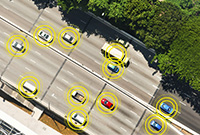 Researcher: Min Song, Professor, Electrical and Computer Engineering
Researcher: Min Song, Professor, Electrical and Computer Engineering
Sponsor: National Science Foundation: NeTS: Small: Collaborative Research
Amount of Support: $221,797
Duration of Support: 3 years
This project investigates fundamental understanding and challenges of inter-vehicle networking, including theoretical foundation and constraints in practice that enable such networks to achieve their performance limits. This is a collaborative research project with Professor Wenye Wang at North Carolina State University.
Summary: Vehicle networks have been playing an increasingly important role in promoting mobile applications, driving safety, network economy, and people’s daily life. It is predicted that there will be over 50 million self-driving cars on the road by 2035; the sheer number and density of vehicles have provided non-negligible resources for computing and communication in vehicular environments. In addition, vehicular communications are also driven by the demands and enforcement of intelligent transportation system (ITS) and standardization activities on DSRC and IEEE 802.11p/WAVE. Many applications, either time-sensitive or delay-tolerant have been proposed and explored, such as cooperative traffic monitoring and control, and recently extended for blind crossing, prevention of collision, real-time detour routes computation, and many others as defined by Car2Car Communication Consortium (C2CCC). Along with the popularity of smart mobile devices, there is also an explosion of mobile applications in various categories, including terrestrial navigation, mobile games, and social networking, through Apple’s App store, Google Play, and Windows phonestore etc. Each aforementioned application seemingly is well-suited for either vehicle-to-vehicle (V2V) ad hoc networks or vehicle-to-infrastructure (V2I) communications. Therefore, vehicular networks have been playing an increasingly important role in promoting mobile applications, driving safety, network economy, and people’s daily life.
In this project, a systematic investigation of vehicular networking properties, which is so called ontology of inter-vehicle communications, will be carried out to acquire in-depth scientific understanding and engineering guidelines that are critical to achieving theoretical performance limits and desirable services. This research includes four key innovative contributions: (i) the discovery of inter-vehicle networks composition by using spectrum cognition in finite and large-scale of V2V and V2I networks, (ii) the space and time domains correlations of vehicles on the move, and development of a set of dissemination strategies using a new constrained mobility model, (iii) detection and identification algorithms to achieve fast neighbor discovery using reinforcement learning, and case-based reasoning scheme; and (iv) theoretical limits of the coverage of messages by following the message trajectory in vehicle networks and schemes to achieve the maximum message coverage in both V2V and V2I networks. The results will advance the knowledge of opportunistic communications and facilitate engineering practice for much-needed applications in vehicular environments.
Intellectual Merit: The intellectual merit of the project centers on the development of theoretical and practical foundations for services using inter-vehicle networks. The project starts from the formation of such opportunistic networks, and then moves on to the coverage of messages, with respect to Euclidean distance and time to stop. Given that an inter-network is in present, the project further studies how resilient such a network under network dynamics, including vehicular movements, message dissemination, and routing schemes. The broader impacts of the proposed research are timely yet long-term, from fully realistic setting of channel modeling, to much-needed applications in vehicular environments, and to transforming performance analysis and protocol design for distributed, dynamic, and mobile systems. Therefore, the proposed research outcome will advance knowledge and understanding not only in the field of vehicular networks, but also mobile ad-hoc networks, cognitive radio networks, wireless sensor networks, and future 5G networks.